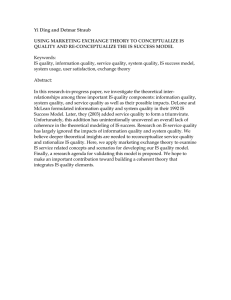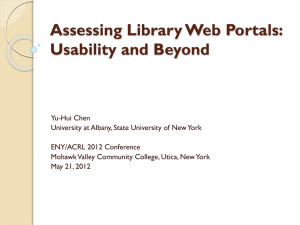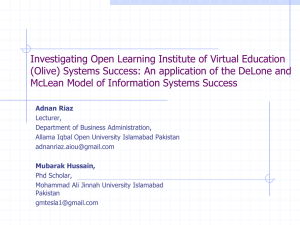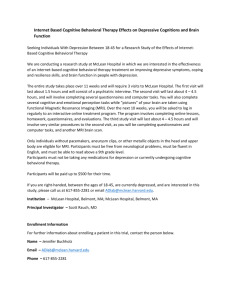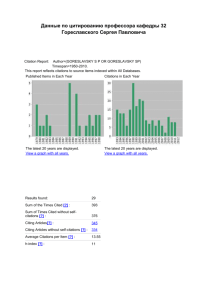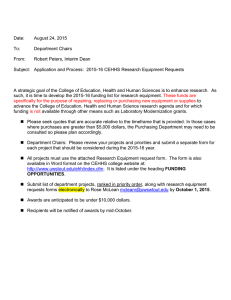ICIS 2007 USING MARKETING EXCHANGE THEORY TO CONCEPTUALIZE IS QUALITY
advertisement
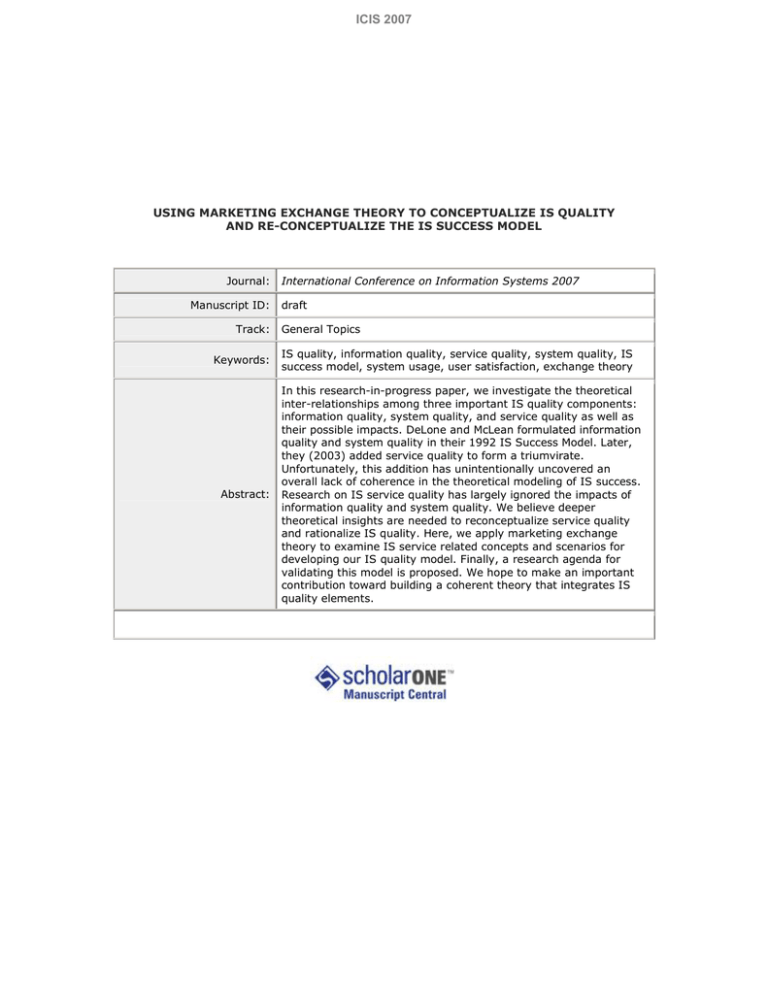
ICIS 2007 USING MARKETING EXCHANGE THEORY TO CONCEPTUALIZE IS QUALITY AND RE-CONCEPTUALIZE THE IS SUCCESS MODEL Journal: Manuscript ID: Track: Keywords: Abstract: International Conference on Information Systems 2007 draft General Topics IS quality, information quality, service quality, system quality, IS success model, system usage, user satisfaction, exchange theory In this research-in-progress paper, we investigate the theoretical inter-relationships among three important IS quality components: information quality, system quality, and service quality as well as their possible impacts. DeLone and McLean formulated information quality and system quality in their 1992 IS Success Model. Later, they (2003) added service quality to form a triumvirate. Unfortunately, this addition has unintentionally uncovered an overall lack of coherence in the theoretical modeling of IS success. Research on IS service quality has largely ignored the impacts of information quality and system quality. We believe deeper theoretical insights are needed to reconceptualize service quality and rationalize IS quality. Here, we apply marketing exchange theory to examine IS service related concepts and scenarios for developing our IS quality model. Finally, a research agenda for validating this model is proposed. We hope to make an important contribution toward building a coherent theory that integrates IS quality elements. Page 1 of 9 ICIS 2007 USING MARKETING EXCHANGE THEORY TO CONCEPTUALIZE IS QUALITY AND RE-CONCEPTUALIZE THE IS SUCCESS MODEL Introduction How can academics and practitioners accurately evaluate the success of information systems (IS)? There have been a myriad of IS studies attempting to define and theorize systems success, but these efforts have been only partly satisfactory. DeLone and Mclean’s work (1992; 2003) is seminal in this regard, but their 2003 study adds constructs and new paths to their original IS success model that are not encompassed by their original theory base. This renders the 2003 model interesting, but not completely coherent. And, therefore, we ask: What can be done to create a stronger, all-encompasssing theory base for this seminal model of IS success? DeLone and Mclean are in a select company of IS researchers who have studied IS quality. Researchers have applied concepts from economic theories (Felthman 1968; Kriebel and Raviv 1980; Marschark 1971), theories based on information communication theory (DeLone and McLean 1992, 2003; Shannon and Weaver 1949), and marketing service quality instruments like SERVQUAL to the study of IS quality components. System quality, information quality, and service quality have been the three main foci of this pursuit, but in spite of decades of attention to this phenomenon, the theoretical underpinning of what makes systems successful has been elusive. What is lacking is a coherent and consistent theoretical treatment to bridge each of these separate IS quality dimensions. DeLone and McLean (1992) applied information communication theory in devising the system quality and information quality dimensions, but their updating of the model lacks theoretical grounding. Studies in IS service quality have applied the marketing-originated SERVQUAL instrument to studying the quality of the human service provided manually by the IS department. Unfortunately, and ironically, many service functions have been automated via sophisticated information technologies, and, in spite of this development, studies of IS service have tended to ignore the ITs that are rapidly becoming an embedded characteristic of service. Overall, these problems saddle DeLone and McLean 2003 IS Success Model (ISM) with an essentially manual view of IS service. This, coupled with lack of theoretical and empirical validation of the unidimensionality and construct validity of system quality, information quality, and service quality, mean that much more work needs to be done in this critical domain. To extend research efforts in IS quality and address the research issues above, the current study describes researchin-progress that attempts to integrate three IS quality components: information quality, system quality, and service quality. This involves reconceptualizing IS service and IS service quality as well as rethinking part of the DeLone and McLean ISM. We also provide propositions based on our theoretical discussion on IS quality. Finally, the latter part of this study offers a research plan for the next stages of empirical investigation and validation of our refined theoretical perspective. Literature Review What is IS Quality? In IS field, there have been ongoing research efforts to help both IS practitioners and researchers evaluate the overall value of IS. In particular, researchers are interested in discovering the major factors that represent success of an IS and how to measure them. A lot of research has been focused on finding factors and measures that could capture the essential characteristics of an IS such as improving organization business performance, achieving its intended function (Ahituv 1980), and satisfying user needs (Ives and Olson 1984). Some has assesse the economic value of an IS (Felthman 1968; Kriebel and Raviv 1980; Marschark 1971). However, such factors and measures might not capture the intangible or indirect value generated by systems. In complementing those economic measures, IS quality is believed to be only one aspect that needs to be evaluated to determine overall IS success (DeLone and McLean 1992, 2003). In the past, evaluating IS quality has stressed the Twenty Eighth International Conference on Information Systems, Montreal 2007 1 ICIS 2007 General Track quality of IS information output (Ahituv 1980; Gallagher 1974; Zmud 1978) and the quality of system performance (Hamilton and Chervany 1981; Swanson 1974). As different studies built their own quality measures, DeLone and McLean (1992) were inspired to systemize the existing work by building a body of knowledge on two quintessential quality components: system quality and information quality. These two IS quality components are the linchpins of their IS Success Model which, in turn, relies on Shannon and Weaver’s (1949) information communication theory. IS Quality Dimension #1 - Information quality Information quality has always been an important construct in IS literature. Existing research work in this area has measured information output quality through scale items such as information format, reliability, and usefulness (Zmud 1978). In DeLone and McLean’s ISM, information quality is defined as effectiveness measures of IS semantic level outputs, which are information products “primarily in the form of reports” (DeLone and McLean 1992, p. 64). In their two studies, DeLone and McLean (1992, 2003) conclude that information quality causally affects other variables such as Use and User Satisfaction. To achieve this, they employ a communication system approach developed by Mason (1978) and originally derived from Shannon and Weaver’s information communication theory (1940). Examples of information quality include report format (Zmud 1978), appearance, accuracy (Olson and Lucas 1982), and information value (Munro and Davis 1977). IS Quality Dimension #2 - System quality In the ISM (1992, 2003), system quality is defined as effectiveness measures of the technical level output of an IS, in accordance with information theory. Alternatively, this construct can be thought of as tapping into the system process of producing and delivering information for users. Following Mason’s extension of communication theory (1978) and the findings of numerous empirical studies, DeLone and McLean (1992) propose that system quality causally impacts Use and User Satisfaction. In the past, IS researchers have developed various system quality measures to evaluate the influence of system technical characteristics on other variables, variables such as user perceived effectiveness (Srinivasan 1985). Examples of these measures include response time, system reliability, flexibility, integration, and so forth (Delone and McLean 1992, 2003; Vandenbosch and Huff 1997; Hamilton and Chervany 1981; Swanson 1974; Wixom and Watson 2001). Figure 1. Relevant Portion of DeLone and McLean 2003 Success Model IS Quality Dimension #3 - IS Service quality Compared with information quality and system quality, research on IS service quality is relatively recent. Arguing from a marketing service perspective, Pitt and Watson (1995) assert that IS success studies should include service quality because service attributes are an inseparable part of IS attributes. Their logic is that IS service attributes determine IS success just as product attributes determine success in sales of products. Although Pitt and Watson (1995) argue that IS quality can be studied via two units of analysis, namely, the IS department and a particular system, the vast majority of studies in this vein only evaluate the effectiveness of IS departments (Dyke et al. 1997; 2 Twenty Eighth International Conference on Information Systems, Montreal 2007 Page 2 of 9 Page 3 of 9 ICIS 2007 Jiang et al. 2002; Kettinger and Lee 1997, 2005; Pitt and Watson 1995, 1997). The primary measurement instrument used is SERVQUAL, an instrument originally developed for marketing studies. Acknowledging the importance of the service dimension in measuring IS success, DeLone and McLean added service quality in 2003 as a separate quality dimension in their updated ISM (relevant portion the model is shown in Figure 1). Nevertheless, this inclusion goes beyond the scope of their original application of information communication theory and is essentially unjustified from a theoretical standpoint. In that very few extant IS studies have examined service quality in the presence of the original IS quality components of information quality and system quality, much more work is needed to better theorize the relationships of information quality, system quality, and service quality to ISM outcomes. Empirical work is also needed to validate the unidimensionality and content, construct, and nomological validity of these three IS quality constructs. Need to Reconceptualize IS Service Quality Research The dominant view of IS service in the extant IS research focuses on human-delivered service. This viewpoint needs to be adjusted to recognize the new reality of service businesses today, businesses that are either reengineered or thoroughly automated through the application of sophisticated IT. One prominent example is Internet technologies that enable virtual businesses such as Amazon, Ebay, and Google. In particular, “the explosively [sic] growing use of self-service technologies (SSTs)” (Rust and Kannan 2002, p. 13-14) has dramatically changed service models of many businesses that some of these information-based services have built their business strategies “entirely around Internet access and delivery” (Lovelock and Wirtz 2004, p. 8). According to Zeithaml, et al. (1990), one important determinant in assessing service quality is communications between service providers and customers. Important to note is that the main communications between these service businesses and their customers are powered by responsive systems that require little human involvement. In such cases, technological characteristics become an inseparable part of the service attributes and customers perceive service quality to largely depend on the quality of the technologies to provide automated services. What this implies is that other IS quality components such as information quality and system quality can become, under such conditions, critical contributors to the service quality dimension. Service delivered by systems and not people intrudes into the traditional domain of system quality and this broader view of IS service is in keeping with latest applications of IT in service businesses. It requires us to reexamine the concept of IS service quality by see other IS quality components such as information quality and system quality as service. First, though, we need a deeper understanding of IS service. Service in Marketing Research In the marketing literature, services have become an important research topic as they take on a more and more dominant role in our economy (Gutek, 1995; Lovelock and Wirtz 2004). In general, service is considered to be a deed, act or performance offered by one party to another (Lovelock and Wirtz 2004; Parasuraman et al. 1985). Fundamentally, service represents a process rather than a particular object (Shostack 1987; Solomon 1985). Service has been studied in accordance with its relevant marketing characteristics. These include the nature of service and types of relationships between service providers and their customers (Lovelock 1983). Studies of the nature of services explore those attributes that distinguish services from goods. Although there is still ongoing debate as to whether there is a clear cut difference between services and goods, researchers in this area have identified quite a few unique service characteristics, features such as intangibility, heterogeneity, inseparability, and perishability (e.g., Lovelock and Gummesson 2004; Parasuraman et al. 1985). In studies of the relationships between service providers and customers, service is characterized by a high degree of interaction between a customer and a service provider. Studies in this area have examined the relationship between service organizations and customers (e.g., Berry 2002; Lovelock 1983; Zablah 2005) and roles of service interaction participants (e.g., Bitner et al 1994; Gutek 1995; Sheth 1967; Solomon 1985;). Studies focusing on service relationship characterize some services as transactional and others as relational. In transactional service, customers and service providers engaging in existing exchange do not expect future exchange. Relational service is portrayed as intensive coordination, mutual commitment and anticipatory of future ongoing interactions (Gutek 1995; Zablah 2005). Studies focusing on service roles apply role theory in studying dyadic service interactions. Using this theory base, they have examined the different roles that service customers and providers can play and their impact on service satisfaction. According to Solomon et al. (1985), service satisfaction is “a function of the congruence between perceived behavior and the behavior expected by role players” (p. 103). Other studies show that the ability Twenty Eighth International Conference on Information Systems, Montreal 2007 3 ICIS 2007 General Track to build the right type of service relationships with the right type of customers can affect a service provider’s profitability (e.g., Reinartz et al. 2004; Sawhney and Zabin 2002). Exchange Implied in Service According to Gutek (1995), the essential element of service is “a special kind of interaction” (p. 1), one that typically involves customers and service providers exchanging money for deliverables. In sociology, researchers (Blau 1964; Homans 1961) developed exchange theory to model the social exchange behavior that usually involves a “two-sided, mutually contingent, and mutually rewarding process” (Emerson 1976, p.336). Bagozzi (1975) was one of the first marketing scholars to apply exchange theory to the study of marketing. According to Bagozzi, marketing concepts should be framed broadly as exchanges, which mean that there are both tangible and intangible as well as direct and indirect aspects to the transfers. He defines three types of exchange: (1) restricted or “two-party reciprocal relationships” (p. 32); (2) generalized or “univocal and reciprocal relationships among at least three actors in exchange” (p. 33); and (3) complex or “a system of mutual relationships between at least three parties” (p. 33). However, in spite of this theoretical development, the exchange nature implied about all services has been rarely set forth as a basis for understanding in existing IS service research. Service Quality in Marketing This is not to say that research on service quality has not assumed a point of view about the nature of service. Consider SERQUAL. This widely-used instrument for measuring service quality is based on distinct service characteristics such as intangibility, responsiveness, and reliability (Parasuraman et al. 1985). Yet, studies in service quality using SERVQQUAL have seldom examined service quality from a relationship perspective. One early exception is Lehtinen and Lehtinen (1982). They propose service quality as an interaction between a customer and a service provider. In particular, Lehtinen and Lehtinen (1982) develop three quality dimensions: (1) physical quality representing the physical aspects of the service; (2) corporate quality representing the company’s reputation; and (3) interactive quality representing the quality of service interactions. Theoretical Development Although the nature of service has often been at the heart of studies of IS service quality (Pitt and Watson 1995; Jiang et al 2002), we believe that this base is insufficient for theorizing about the modern, complete role of IT in supporting services. What is needed is a stronger conceptual foundation for relationships among three IS quality components: IS service quality, information quality, and system quality. Given the exchange nature of service (Bagozzi 1975; Gutek 1995; Kotler 1972), we believe that marketing exchange theory can guide our initial effort toward theoretical integration of IS quality components. Reconceptualization IS Service To do this, we first need to clearly state what we mean by service. We use service to refer to a series of interactions that occur between customers and service providers in satisfying customer needs. The term has not been standardized in prior service studies (Solomon 1985; Gutek 1995), and this may be part of the reason that the domain has not built a stronger cumulative tradition. Here, interaction is any instance in which two active parties, having the ability to exert influence upon each other, engage in an exchange of value (Cunningham 1980; Ford 1980; Kotler 1972; Turnball et al. 1996). Usually, an interaction focuses on the exchange of core benefits (i.e., goods and services for money), information exchange, social exchange (i.e., interpersonal exchange), and/or any combination of the three (Cunningham 1980; Kalafatis 2002; Metcalf et al. 1993). Traditionally, service exchange has been restricted to human actors, and systems have not been considered to be legitimate service providers in their own right. In short, service systems have been relegated to the role of taskassisting tools. With new information technologies such as e-Learning and training systems, knowledgebases, FAQs and the Internet, VoIP, voice-reading response systems, and the like providing immediate, direct services to customers, the conceptual separation of systems from service needs to change. These technologies not only assist human agents in serving customers, but they can sometimes replace them entirely (Gutek 1995). For customers, expectations regarding service are also shaped by these new technologies (Rust and Kannan 2002). Now, with the 4 Twenty Eighth International Conference on Information Systems, Montreal 2007 Page 4 of 9 Page 5 of 9 ICIS 2007 growth of systems in providing service, we can identify three relevant service exchanges: (1) exchanges between a system and an IS user, (2) exchanges between an IS user and a human IS service agent, and (3) exchanges between a human IS service agent and a system. Reconceptualization of IS Quality from an Exchange Theory Perspective In the IS literature, there is a lack of clear agreement on what constitutes “quality.” In existing, related studies in the management literature, Reeves and Bednar (1994) identified four definitions of “quality”: (1) quality as excellence, (2) quality as value, (3) quality as conformance to specification, and (4) quality as meeting and/or exceeding customer’s expectations. Although Reeves and Bednar (1994) argue that these definitions of quality are distinct from each other, viewed from an exchange perspective, they may be referring to the same thing. That is, the value provided by an organization is perceived to be of worth by a customer. According to marketing exchange theory (Bagozzi 1975), the value for which the exchange takes place includes direct and/or indirect value, the latter of which usually being delivered through an indirect exchange. By defining quality as excellence (Reeves and Bednar 1994), the organization seeks agreement from its customers about the terms of exchange. These are not just about direct economic value but also about indirect values such as customer loyalty, social recognition, etc. The definition of quality as value (Reeves and Bednar 1994) reflects the economic role that value plays in the exchange between an organization and its customers. According to Reeves and Bednar (1994), a primary reason for defining quality as conformance to specification is to maintain high reliability, interchangeability, and low cost. Again, high reliability and interchangeability can be considered to be indirect values that organizations can offer to their customers in an exchange. Low cost would be a direct economic value that can be offered by organizations. Certainly, it is up to customers to decide whether these are worth the exchange. Finally, Reeves and Bednar (1994) point out that the definition of quality as “meeting and/or exceeding customer expectations” (p. 433) is also an appropriate conceptualization of service quality by marketing scholars such as Gronroos (1983) and Parasuraman et al. (1985). From an exchange perspective, this definition speaks about essentially the same thing as the other quality definitions. According to Bagozzi (1975), one critical characteristic that a restricted exchange (a two-party reciprocal relationship) exhibits is an “attempt to maintain equality” (p. 33) because “retailers, for example, know that they will not obtain repeated purchases if the consumer is taken advantage of and deceived” (p. 33). Therefore, meeting customer expectations is an organizational effort toward maintaining this equality. However, it is the customer’s perception as to whether this equality is achieved. Exceeding a customer’s expectation simply implies that there is an extra value that an organization is willing to offer in exchange for indirect value from a customer, such as customer loyalty. Considering the above view of IS service and our proffered definition of quality, we can now provide definitions of the three IS quality components: information quality, system quality, and service quality. • System quality: the technical value in an exchange that is provided by an IS. This is the value that an IS exhibits when it is used to assist in the delivery of service. Since the system functions provided by an IS can be considered to be a servicing of service, service provided by an IS is instrumental in executing service exchanges with customers. The concept is similar to the non-IS context where, for example, UPS provides shipping service to a service organization in executing service exchanges with its own customers. • Information quality: the output value generated by an IS in an exchange. • Service quality: the overall value delivered through a series of exchanges Next, with a primary focus on intra-organizational IS services and external organizational online IS service, we develop two different service scenarios based on this exchange perspective (Figures 2 and 3). By analyzing these scenarios and their implications, we attempt to elicit the theoretical relationships that exist among IS service quality, information quality, and system quality as defined above. IS Service Scenario I – Human IS Service for End-user In the IS service scenario depicted in Figure 2, IS provides an informational service to satisfy an IS user’s need such as the need to work with and understand an IS application (e.g., Bailey and Pearson 1983; Baroudi and Orlikowski 1988; Ives et al. 1983; Zmud 1978). In this case, the human agent is in the IS department, an organizational subunit that provides direct end-user support services such as training, documentation, and maintenance for satisfying users Twenty Eighth International Conference on Information Systems, Montreal 2007 5 ICIS 2007 Page 6 of 9 General Track IS needs (Kettinger and Lee 1994; Pitt and Watson 1995). Existing studies of IS information quality and system quality tend to focus on service exchanges between systems and IS users (the left side of Figure 2). Existing studies of IS service quality, however, tend to focus on the other side (the right side) of the exchange, that is, the service exchange between human agents in the IS department and the IS user. Quality constructs have been developed for each side independently, neither taking into consideration the other form of exchange. From a value exchange perspective (Bagozzi 1975), these two sides should not be thought of as entirely independent. The sequence of service activities, as shown in Figure 2, creates IS service value through the exchanges carried out by the human agents servicing the customers as well as by the information and system quality of the applications. That is, part of the service support received by an IS user is not through a direct exchange with the IS department but through an indirect exchange embedded in the systems themselves. In this case, we can argue that higher service quality should be reflected in higher system and information quality because the primary service goal of the IS department is to assist end-users in “converting data into information” (Pitt and Watson 1995, p. 173). Certainly, one can argue that a very real portion of system and information value is created indirectly through the human agency of IS department service. That is, service quality is inextricably tied to information quality and system quality. Yet, logically and contrariwise, both information quality and system quality are quality components that have separate definitions. They capture either the information output characteristics or the system characteristics of the IS itself (DeLone and McLean 1992; Seddon 1997). Therefore, in this traditional scenario, service quality cannot partake of information quality or system quality measures. Figure 2. Human IS Service for End-Users Figure 3. Service Provided by an IS IS Service Scenario II – Service Provided By IS In the not-too-distant future, the overwhelming proportion of service delivery will be carried out through systems rather than human agents. The likely hegemony of this scenario (Figure 3) helps to resolve the apparent dilemma in how we conceptualize and model IS service. Here the provider renders service to its customers primarily through the IS itself. Direct face-to-face interaction between a customer and a human service agent is minimized. Even today many self service technologies that do not call for the direct involvement of human service agents are being used by service organizations (Meuter et al, 2000). Other examples of such services include: online travel services, UPS package tracking services, and online banking services. In those cases, an IS serves as the central medium of exchange between a service provider and its customers. The quality of this exchange medium influences customer satisfaction with the overall service exchange proffered by the service provider (Bagozzi 1975). Therefore, quality resides in the IS itself. It embodies information quality and system quality and these become indispensable components considered by customers when they form perceptions of the overall service quality provided by the service organization. This view is especially relevant to DeLone and McLean’s 2003 model, which, purportedly, was designed to accommodate the ISM to the world of e-Commerce. An Alternative IS Quality Model and Propositions The scenario analysis elaborated here is based on a marketing service exchange perspective. In applying it to DeLone and McLean’s ISM, we propose alternative nomological linkages among three IS quality components, system quality, information quality, and service quality, as well as new paths depicting their impact on the 6 Twenty Eighth International Conference on Information Systems, Montreal 2007 Page 7 of 9 ICIS 2007 downstream constructs of intention to use, use, and user satisfaction. Clearly, the bulk of this model depends directly on DeLone and McLean’s updated IS Success Model (2003), a model that has yet to be subjected to rigorous empirical testing. Thus, while DeLone and McLean (2003) propose that service quality will impact variables downstream including intention to use, use and user satisfaction, very few studies have tested these relationships (Petter and McLean 2006). Figure 4. Alternative IS Quality Model Based on this alternative IS quality model (Figure 4) and theoretical concepts, we state the following propositions for future empirical testing: P1: Service quality mediates both the relationship between system quality and intention to use/use and the relationship between system quality and user satisfaction in a positive direction. P2: Service quality mediates both the relationship between information quality and intension use /use and the relationship between information quality and user satisfaction in a positive direction. P3: Service quality has a positive impact on intention to use /use and user satisfaction. P4: Intention to use/ use has a reciprocal relationship with user satisfaction. An Agenda for Further Empirical Study In this paper, we have presented a nascent theoretical discussion of IS quality components. Our next step will focus on the empirical testing of the alternative ISM proposed here (Figure 4). The empirical study will be conducted in two phases: (1) instrument development and validation and (2) theory-testing. During the first phase, our focus will be on developing a valid instrument from existing measures of IS quality components. In particular, we will adopt a Q-Sorting methodology to test the content validity of system quality, information quality, and service quality constructs. Findings from this step will provide input for instrument development. Then, pilot tests will test measurement reliability and validities. During the second phase, we will design several experiments to test factorial validity of IS service quality, information quality, and system quality. Then, SEM techniques will be applied to test the robustness of our alternative IS model. Conclusion Through theoretical discussions of how service quality, information quality, and system quality are related to each other and to ISM outcomes, this research hopefully contributes to a deeper theoretical understanding of IS service quality, system quality, and information quality. In particular, this research attempts to build a long needed theoretical base for IS quality studies. Future research will empirically validate this theoretical conceptualization of IS quality. Through the program of study, we will examine how different IS quality constructs are related to each other and how they affect downstream constructs such as use, intention-to-use, and satisfaction. Future empirical studies that extend this research may be able to full verify the ISM. This seminal model, originally proposed by DeLone and McLean in 1992 and updated in 2003, has the ambitious and laudable goal of better assessment of the effectiveness of information systems. The implications of the research should help IS managers see better how various IS qualities can impact customer satisfaction and intentions to use an IS. With this insight, IS managers can develop more effective IS quality and achieve overall IS success. Twenty Eighth International Conference on Information Systems, Montreal 2007 7 ICIS 2007 General Track References Ahituv, N. "A Systematic Approach Toward Assessing the Value of an Information System," MIS Quarterly (4:4), December 1980, p 61. Ahituv, N. "A Systematic Approach Toward Assessing the Value of an Information System," MIS Quarterly (4:4), December 1980, p 61. Bagozzi, R.P. "Marketing as Exchange," Journal of Marketing (39), October 1975, pp 32-39. Bailey, J.E., and Pearson, S.W. "Development of a tool for measuring and analyzing computer user satisfaction " Management Science (29:5), May 1983. Baroudi, J.J., and Orlikowski, W.J. "A Short-From Measure of User Information Satisfaction: A Psychometric Evaluation and Notes on Use," Journal of Management Information Systems (4:4) 1988. Berry, L.L. "Relationship Marketing of Services-Perspectives from 1983 and 2000," Journal of Relationship Marketing (1:1) 2002, pp 59-77. Bitner, M.J., Booms, B.H., and Mohr, L.A. "Critical Service Encounters: The Employee's Viewpoint," Journal of Marketing (58:4), October 1994, pp 95-106. Dyke, v., P., T., and Kappelman, L.A. "Measuring information systems quality: Concerns on the use of the SERVQUAL questionnaire," MIS Quarterly (21:2) 1997. Emerson, R.M. "Social Exchange Theory," Annual Review of Sociology (2) 1976, pp 335-362. Feltham, G.A. "The Value of Information," The Accounting Review (43:4), October 1968. Gallagher, C.A. "Perceptions of the Value of Management Information System," Academy of Management Journal (17:1) 1974, pp 46-55. Gronroos, C. "Creating a Relationship Dialogue: Communication and Value,") 2000. Hamilton, S., and Chervany, N.L. "Evaluating Information System Effectiveness - Part I: Comparing Evaluation Approaches," MIS Quarterly (5:3) 1981, pp 55-69. Hormans, C.G. "Social Behavior as exchange," American Journal of Sociology (62) 1958, pp 597-606. Ives, B., Olson, M.H., and Baroudi, J.J. "The Measurement of User Information Satisfaction," Communications of the ACM (26:10) 1983. Jiang, J.J., Klein, G., and Carr, C.L. "Measuring Information System Service Quality: SERVQUAL From the Other Side," MIS Quarterly (26:2), June 2002, pp 145-166. Kettinger, W.J., and Lee, C.C. "Perceived service quality and user satisfaction with information services function," Decision Sciences (25:5,6), Sep-Dec 1994. Kettinger, W.J., and Lee, C.C. "Pragmatic Perspectives On The Measurement Of Information Systems Service Quality," MIS Quarterly (21:2), June 1997, p 18. Kettinger, W.J., and Lee, C.C. "Zones of Tolerance: Alternative Scales for Measuring Information System Service Quality," MIS Quarterly (29:4) 2005. Kotler, P. "A Generic Concept of Marketing," Journal of Marketing (36), April 1972. Kriebel, C., and Raviv, A. "An Economics Approach to Modeling the Productivity of Computer Systems," Management Science (26:3), March 1980, pp 297-311. Lambe, C.J., Spekman, R.E., and Hunt, S.D. "Intermistic Relational Exchange: Conceptualization and Propositional Development," Journal of the Academy of Marketing Science (28), Spring 2000. Lehtinen, U., and Lehtinen, J.R. "Service Quality: A Study of Quality Dimensions," Helsinki: Service Management Institute, Finland OY, 1982. Lovelock, C., and Gummesson, E. "Wither Services Marketing? In Search of a New Paradigm and Fresh Perspective," Journal of Service Research (7:1), August 2004. Lovelock, C., and Wirtz, J. Service Marketing: People, Technology, Strategy, (5th ed.) Prentice Hall, Upper Saddle River, N.J., 2004. Lovelock, C.H. "Classifying Services to Gain Strategic Marketing Insights," Journal of Marketing (47), Summer 1983. Marschark, J. "Economics of Information Systems," Journal of the American Statistical Association (66:333), March 1971. Mason, R.O. "Measuring Information Output: A Communication Systems Approach," Information & Management (5:1) 1978, pp 219-234. Meuter, M.L., Ostrom, A.L., Roundtree, R.I., and Bitner, M.J. "Self-Service Technologies: Understanding Customer Satisfaction with Technology-Based Service Encounters," Journal of Marketing (64), July 2000. Munro, M.C., and Davis, G.B. "Determining Management Information Needs: A Comparison of Methods," MIS Quarterly (1:2), June 1977, pp 55-67. 8 Twenty Eighth International Conference on Information Systems, Montreal 2007 Page 8 of 9 Page 9 of 9 ICIS 2007 Olson, M.H., and Lucas, H.C. "The Impact of Office Automation on the Organization: Some Implications for Research and Practice," Communications of the ACM (25:11), November 1982, pp 838-847. Parasuraman, A., Zeithaml, V.A., and Berry, L.L. "A Conceptual Model of Service Quality and Its Implications for Future Research," Journal of Marketing (49:4) 1985, pp 41-50. Parasuraman, A., Zeithaml, V.A., and Berry, L.L. "SERVQUAL: A Multiple-Item Scale for Measuring Consumer Perceptions of Service Quality," Journal of Retailing (64:1) 1988, pp 12-40. Parasuraman, A., Zeithaml, V.A., and Berry, L.L. "Refinement and Reassess of the SERQUAL Scale," Journal of Marketing (67:4) 1991, pp 420-450. Petter, S., and McLean, E.R. "A Meta-Analytic Assessment of the DeLone and McLean IS Success Model and Its Alternatives," in: Working Paper, Georgia State University, Atlanta, 2004. Pitt, L.F., and Watson, R.T. "Service Quality: A Measure Of Information Systems Effectiveness," MIS Quarterly (19:2), June 1995, p 15. Pitt, L.F., Watson, R.T., and Kavan, C.B. "Measuring information systems service quality: Concerns for a complete canvas," MIS Quarterly (21:2) 1997. Reeves, C.A. "Defining Quality: Alternatives and Implications," Academy of Management Review (19:3) 1994, pp 419-445. Reeves, C.A., and Bednar, D.A. "Defining Quality: Alternatives and Implications," Academy of Management Review (19:3) 1994, pp 419-445. Reinartz, W.J., Krafft, M., and Hoyer, W.D. "The CRM Process: Its Measurement and Impact on Performance," Journal of Marketing Research (41), August 2004. Rust, R.T., and Kannan, P.K. The Era of e-Service M.E. Sharpe, Inc, Armonk, New York, 2002. Sawhney, M., and Zabin, J. "Managing and Measuring Relational Equity in the Network Economy," Journal of the Academy of Marketing Science (30), Fall 2002. Seddon, P.B. "A Respecification and Extension of the DeLone and McLean Model of IS Success," Information Systems Research (8:3), September 1997. Shannon, C.E., and Weaver, W. The Mathematical Theory of Communication University of Illinois Press, Urbana, IL, 1949. Shostack, G.L. "Breaking Free from Product Marketing," Journal of Marketing (41), April 1977, pp 73-80. Shostack, G.L. "Service Positioning Through Structural Change," Journal of Marketing (51), January 1987, pp 3443. Solomon, M.R., Surprenant, C., Czepiel, J.A., and Gutman, E.G. "A Role Theory Perspective on Dyadic Interactions: The Service Encounter," Journal of Marketing (49), Winter 1985. Swanson, E.B. "Management Information Systems: Appreciation and Involvement," Management Science (21:2), October 1974. Turnbull, P., Ford, D., and Cunningham, M. "Interaction, Relationships and Networks in Business Markets: An Evolving Perspective," Journal of Business and Industrial Marketing (11:3/4) 1996, pp 44-62. Vandenbosch, B., and Huff, S.L. "Searching and Scanning: How Executives Obtain Information from Executive Information Systems," Management Science (21:1), March 1997, p 27. Wixom, B.H., and Watson, H.J. "AN EMPIRICAL INVESTIGATION OF THE FACTORS AFFECTING DATA WAREHOUSING SUCCESS," MIS Quarterly (25:1), March 2001, pp 17-41. Zablah, A.R. "A Communication Based Perspective on Customer Relationship Management Success," in: Marketing, Georgia State Unviersity, Atlanta, 2005. Zmud, R.W. "An Empirical Investigation of the Dimensionality of the Concept of Information," Decision Science (9:2), April 1978, pp 187-195. Twenty Eighth International Conference on Information Systems, Montreal 2007 9
